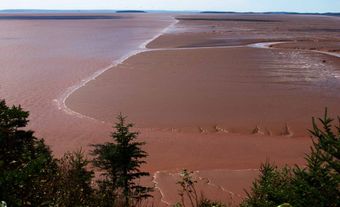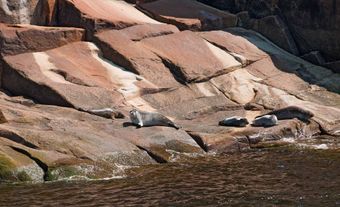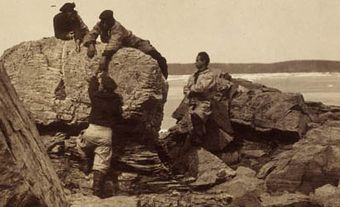The Gulf of St Lawrence, a large (250,000 km2), roughly triangular inland sea receiving on average 10,100 m3/s of fresh water from the St. Lawrence River at its northwest apex, is connected to the Atlantic by the Strait of Belle Isle at the northeast and Cabot Strait at the southeast corners.

Geography
The deep Laurentian Channel extends from the St Lawrence estuary near Tadoussac, Quebec, through the Cabot Strait to the edge of the Continental Shelf. To the south lie the Iles de la Madeleine and Prince Edward Island, with the extensive Magdalen Shallows in between. North of the channel is Ile d'Anticosti. Additional sources of fresh water include the Saguenay River and other north shore rivers, plus smaller amounts from New Brunswick and Newfoundland.
Hydrology
Much of the runoff is entrained in the Gaspé Current, flowing along the south shore of the estuary, out onto the Magdalen Shallows and eventually around the northern tip of Cape Breton Island to form the Nova Scotian Current. This freshwater's physical and biological effects are detectable as far away as the Gulf of Maine. Newfoundland Shelf water enters the gulf on the eastern side of Cabot Strait, drifts northeast along the west coast of Newfoundland and, coupled with a westerly drift along the north shore, completes a large counterclockwise gyre in the surface circulation.
The deep inflow of Atlantic water through Cabot Strait compensates for the net outflow of surface waters. Winter cooling and contributions from the Labrador Shelf via Belle Isle Strait result in significant ice cover (and associated navigational hazards) in the gulf for at least three months each winter.
History
Before European contact, the gulf was frequented by Indigenous peoples, such as the Mi'kmaq, who came seasonally to fish. The north shore of the gulf was also inhabited by Inuit. Jacques Cartier explored the gulf in 1534 but was likely preceded in the area by Basque fishermen.
Present Day
The gulf, with the St Lawrence River and St. Lawrence Seaway, forms a transportation corridor to the heartland of industrial North America, carries away its waste products, and still yields about one-quarter of Canadian fish landings, both by weight and by value.

 Share on Facebook
Share on Facebook Share on X
Share on X Share by Email
Share by Email Share on Google Classroom
Share on Google Classroom





